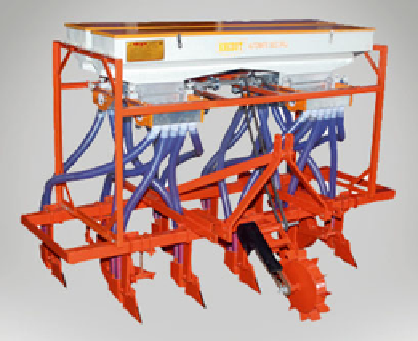Agriculture Reference
In-Depth Information
• Zero-tillage causes stratifi cation of soil
organic carbon content with relatively
higher concentration in the surface and
lower in the subsoil compared to plow-
based methods of seedbed preparation. The
ratio of soil organic carbon content for
zero-tillage to plow-till system remains.
(iii)
Strip-tillage
: Strip-tillage involves tilling
the soil only in narrow strips with the rest of
the fi eld left untilled (strip-till) (MDA
2011
).
(iv)
Ridge-tillage
: Ridge-till involves planting
seeds in the valleys between carefully
molded ridges of soil (Fig.
13.4
). The previ-
ous crop's residue is cleared off ridgetops
into adjacent furrows to make way for the
new crop being planted on ridges.
Maintaining the ridges is essential and
requires modifi ed or specialized equipment
(MDA
2011
).
(v)
Mulch-tillage
: Mulch-till (Fig.
13.5
) is
another reduced tillage system in which
residue is partially incorporated using chis-
els, sweeps, fi eld cultivators, or similar
farming implements that leaves at least one-
third of the soil surface covered with crop
residue (MDA
2011
).
Each conservation tillage method requires its
own type of specialized or modifi ed equipment
and adaptations in management.
(vi)
Advantages
• Increases the ability of soil to store or
sequester carbon while simultaneously
enriching the soil.
• Improves soil water infi ltration, thereby
reducing erosion and water and nitrate
runoff.
• Improves the stabilization of soil surface
to wind erosion and the release of dust
and other airborne particulates.
• Reduces leaching of nutrients due to
greater amounts of soil organic matter to
provide binding sites.
• Decreases evaporation and increases soil
moisture retention, which can increase
yields in drought years (Suddick et al.
2010
).
• Reduces the number of passages of
Fig. 13.3
Photograph showing zero-tillage sowing
implement
(ii)
Feasibility of technology and operational
necessities
: Features of zero-tillage include:
• Crop residues are distributed evenly and
left on the soil surface.
• No implements are used to turn the soil
over, to cultivate the crops, or to incor-
porate the crop residues into the soil.
• Weeds and cover crops are controlled by
a preplanting application of non-pollutant
desiccant herbicides.
A specialized planter is used to cut crop resi-
dues on the soil surface and insert the seeds and
fertilizers into the soil with minimum distur-
bance. Generally seed sowing is done when soil
moisture content is adequate for seed germina-
tion but not so high that the large tractor and
planter would compact the soil.
• Weed control is also accomplished with
pre- and postemergence herbicides.
• Crop rotation is fundamental to zero-tillage
because it helps to minimize weed, insect,
and disease populations that increase when
the same crop is grown year after year on
the same ground.
• Most experiments with zero-tillage have
had increased yields, but in the wetter areas,
it took many years to see the crop yields
stabilize or increase. However, in drier
areas where moisture is the major limiting
factor, the effects on yield were seen even in
the fi rst year (Kimble et al.
2007
).

Search WWH ::

Custom Search